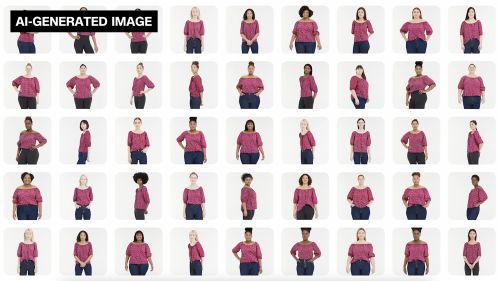Buying clothing online has always been problematic. In fact, it has long been one of the most contentious concerns, a reason why people still prefer brick and mortar stores, at least for some things. After all, you never really know how it will fit or even look until you can actually try it on.
When I received my regular Wired Magazine email yesterday with their latest stories, one item caught my attention: Google is now leveraging AI to create an online tool that allows shoppers to “try on” a garment before ordering. Although it is limited to women’s tops for the time being, and specifically only to items available via Google Shopping, it offers hope to women uncertain about pulling the trigger on that order.
Late To The Game
Interestingly, though, Google is a little bit late to the game, just as it was with Bard in the wake of Chat GPT. I’ll forgive them once again, because there is still a lot of room for growth and tweaking in this race. You see, nine months ago Walmart beat Google to the draw when it announced its own Virtual Try-On tool.

Essentially, both programs involve sharing some personal information so the software can then artificially drape the garment onto a virtual model. It’s little different in outcome from going to the fitting room, trying it on, and standing in front of a full-length mirror. Problem solved, right?
Not Really…
Well, not so fast. There are still limitations, not the least of which is a nearly universal inconsistency across women’s clothing brands and garments regarding sizing. Men have it pretty easy, because our shirts and trousers are typically measured in inches. But what is a 12? A 16? An 8?
I’m not even sure that women know, because there is so much variability. Never mind the social pressures we place on women, the result being a downward trend in sizing numbers even if only for the ego, and more confusion than ever. Incorrect fit is the most common reason for returned online clothing purchases.
Amazon has worked to solve this problem with its Amazon Prime Wardrobe program, whereby a customer can have up to seven items sent risk-free; keep what you want, return the rest, and you will be billed accordingly. Many customers thus buy the same garment in several sizes, and keep the one that fits.
All of these returns are costing businesses money. It’s one thing to take three items to the fitting room, and then let an employee return two to the rack. In the online world, the time gap between browsing, buying, and returning can easily hit two weeks.
Back To AI
But back to AI, which we also discussed just yesterday. While the execution is still not perfect with either Google or Walmart’s versions, they are steps in the right direction. Yes, there are some privacy concerns, because the customer is, after all, sharing personal data. In Google’s instance, the customer must select a body type from among 40 examples; in Walmart’s case, the customer uploads a selfie. Still, there is no guarantee the garment will fit perfectly, because everyone, men and women alike, have bulges in places that may defy rational thought and garment manufacturing.
Furthermore, as we all know, our shape will probably ebb and flow over time, thanks to dieting, good or bad, and physical activity—once again, good or bad. Just getting older sees most of us putting on some weight, by virtue of slowing metabolisms. Both of these AI systems would necessarily have to allow customers to update their information.
There are still many challenges for AI in the fitting room, and women’s tops are just the tip of the iceberg. If you think getting a top to fit correctly is tough, just try pants or dresses. And even for the guys, in our relatively simple world, it won’t be that easy. There are too many variables with values in flux to be entered into the algorithm.
To The Future
But it’s fun to watch the computer scientists try to solve these problems nonetheless. If they can indeed address them, it will relieve me of one of the things I hate doing the most: trying on clothes. And it might just cure me of my tendency to buy the same pants in three or four shades once I find one that works.
Here’s to ya, Google and Walmart. Keep going. Shortcomings aside, I’m willing to try this all on for size once you unleash it in the Men’s department.
Dr “Fit To Be Tied” Gerlich


